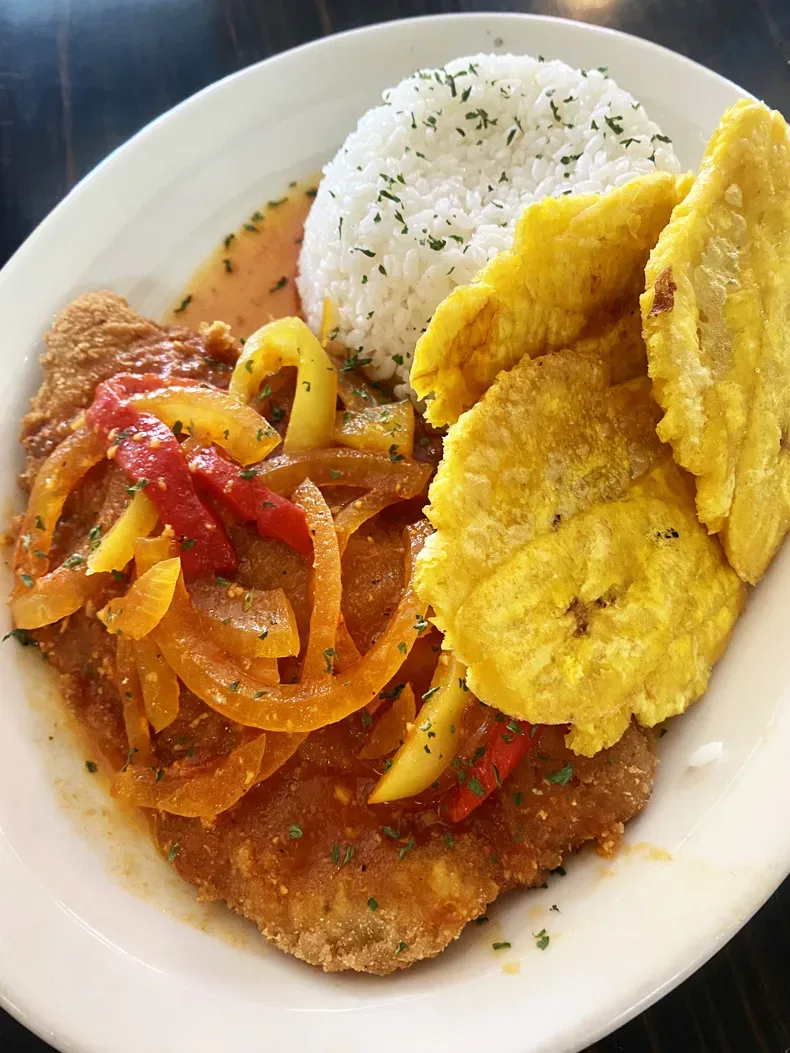Prior to spring-breaking there with the family in 2022, I hadn’t been to Puerto Rico in nearly two decades. And while I have a strong memory of eating excellent mofongo in the mountains while driving around the island for a travel article (as well as some terrific ice cream in Ponce), my recall of delicious and typical foods in Puerto Rico was pretty … nonexistent. I wasn’t sure what to expect on our family foray to San Juan and Fajardo there last April.
Along the north coast we traveled there sure are lots of seafood, plantains, rice and beans, fritters—but below the surface, the overarching influences to know about in modern Puerto Rican cuisine, aka cocina criolla (Creole cooking), include the native Taíno, the Spanish colonizers, and the West African slaves brought to the island. The Spanish introduced the concept of making sofrito—sauteeing and blending tomatoes, peppers, garlic, onion, olive oil, bay leaf, and more to form a base for sauces—that’s so essential to many traditional Puerto Rican dishes (albeit, with a distinct PR spin, thanks to the local ingredients incorporated). Pigeon peas, tamarind, and the methods of frying foods and mashing starches were among the key contributions from West Africans. Native plants used by the Taíno, such as recao (culantro), yuca, and achiote, still figure prominently in the Puerto Rican kitchen today.

You can find great typical Puerto Rican food inside pharmacies, even!
As a whole, Puerto Rican cuisine may be unassuming, and not widely celebrated, but it’s an incredible source of pride for many Puerto Ricans, reflecting resilience and heritage. And I’m happy to report we ate very well on the island, between San Juan, Fajardo in the northeast, and the beautiful beach towns in between. I didn’t even go crazy researching restaurants beforehand, like I usually do. I really wanted a family vacation, and I wanted to find good local eats on the fly. Fortunately, Puerto Rico made this task pretty easy. Traditional Puerto Rican foods far outnumber what we were able to try in a few days, but those we had were delicious and fun to seek out.
Here are some of our favorite typical foods (and drinks) in Puerto Rico, as found along the north coast between San Juan and Fajardo.
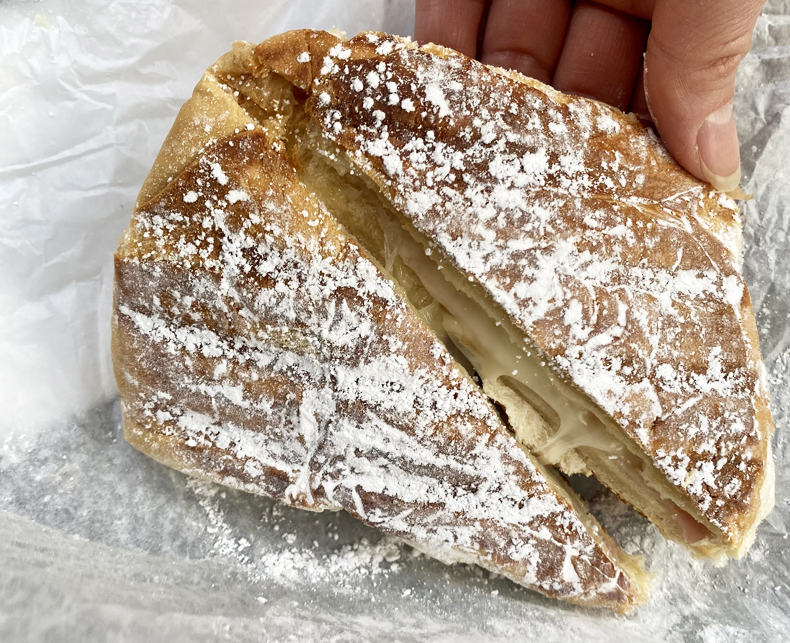
Mallorca
Mallorcas are soft sweet bread rolls showered with powdered sugar, popular for breakfast across Puerto Rico. They’re named for the island of Mallorca, from whence they came and where they’re called ensaimadas (Filipino food fans will recognize the similarity to ensaymadas). Besides being split, buttered, and paired with café con leche (as described in this ode from The New York Times), Puerto Rican mallorcas are also often filled with breakfasty items like cheese, ham, and egg before being buttered and pressed, and then dusted with powdered sugar.
Where: A popular place to try this breakfast delicacy is decades-old Cafetería Mallorca (300 Calle de San Francisco, map) in Old San Juan, which unfortunately for us was closed for a holiday when we visited. But mallorcas can be found in lots of PR bakeries. We tried it in a few places, including from a kiosk at Plaza del Armas called Café Cuatro Estaciones (151 Calle de San Francisco, map). It might not have been the OG mallorca, but, layered with ham and melty cheese inside, it was a delicious pairing of warm and sweet, buttery and savory, to start the day with.
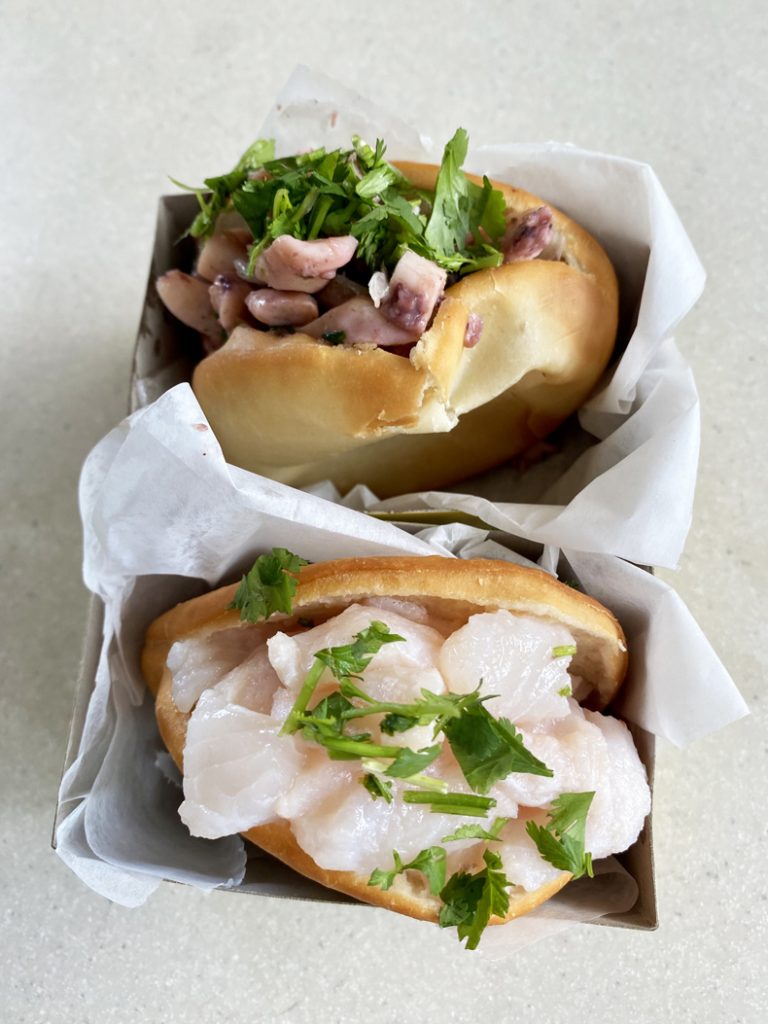
Arepas
If, like me, you thought arepas were limited to the Venezualan and Colombian varieties, think again. Puerto Ricans have their own spin on the arepa, and unlike its South American counterparts, it doesn’t involve corn. Instead, fried wheat-based bread provides the vessel for whatever is being stuffed inside: shrimp, conch, octopus, stewed codfish, ceviche, eggs, chicken, beef, pernil, tripleta (referencing a popular local sandwich containing pork, ham, bacon, and shoestring potatoes). The fillings can be anything.
The bread itself is akin to a biscuit: slightly crispy and oily on the outside, soft and pillowy inside. It’s a perfect little sandwich you can polish off in a few bites. (If you’re hungry, you’ll need a few.)
Where: We feasted on these, ceviche, and a couple of cold Medallas upon our arrival in San Juan (near Ocean Park) at La Preñá (1810 Calle Loíza, map), which is a local chain with several branches and a food truck. We also ate tasty shrimp- and crab-filled arepas at Carlos Seafood (9977+H86, Carr. Cabezas de San Juan, map) in Fajardo. Look for these all along the north coast—they’re everywhere, but typically found in casual seafood spots.

Piragua
Does every Latin American culture have its own spin on shaved ice? Possibly so! Piragua is it for Puerto Ricans, and it’s a popular street snack around the island. Choose from a number of fruity syrups to give your cup of pointed ice a sugary flavor burst—you can pick more than one, but you’re probably best off sticking to no more than two. We (by which I mean our kids) chose pineapple and cherry. It’s refreshing on a hot day.
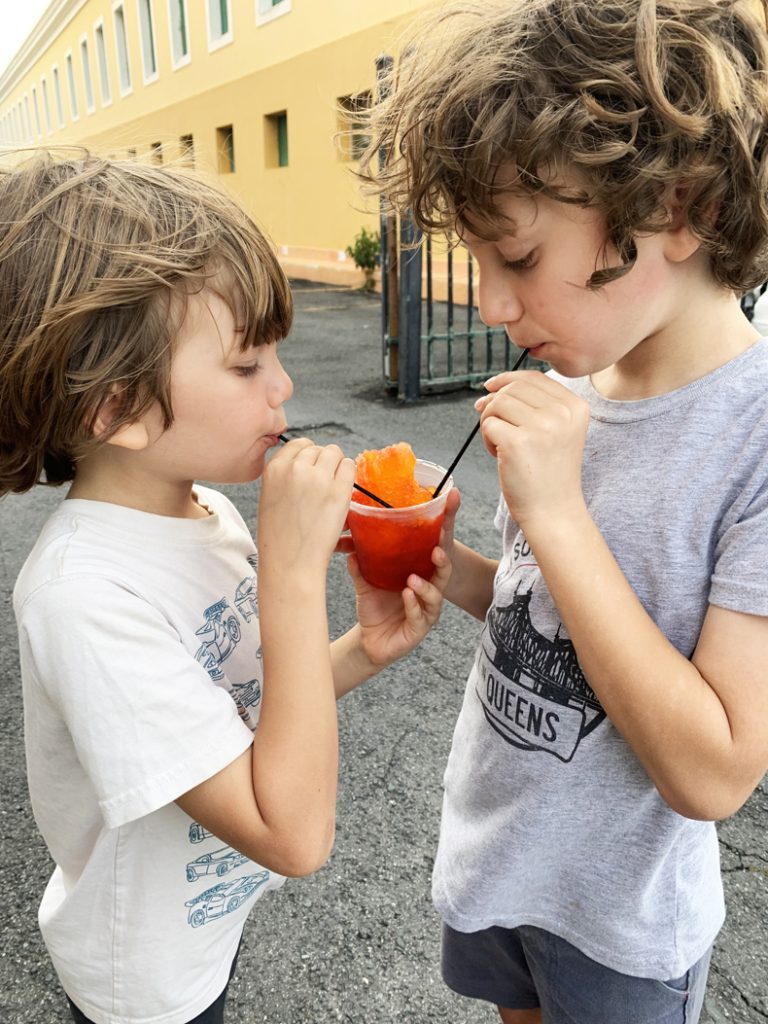
Piraguas are a kid favorite!
Where: Our piragua is from one of the several vendors who hang out around El Morro in Old San Juan, because they know that sweet, artificially flavored shaved ice is just what people want after spending hours under a tropical sun wandering the historic remains of a centuries-old fort. (It really is, though!)

Mofongo with pulpo
Mofongo
One of the best-known Puerto Rican dishes, mofongo is more than just a local food; it’s a way of life around here. Mofongo is mashed, fried plantain with garlic topped with everything from chicharrón (most traditionally) to crab, shrimp, octopus, fried chicken, or steak. It’s a labor-intensive dish, yet we spotted it on many menus, particularly along the coast, where seafood rules.
Anyone familiar with West African food will note mofongo’s similarity to fufu, the ubiquitous mash made with pounded yam or cassava. According to Smithsonian Magazine, while the Spanish conquistadors who arrived here in the 14th century first enslaved the indigenous Taíno, they soon turned to West African slaves for plantation and mining labor. The Taíno had long used pilones (mortars and pestles) to mash corn, spices, and herbs. Once West Africans brought their fufu into kitchens, the idea of mashing a starch took root, and eventually the island’s plentiful green plantains became the star ingredient. Mofongo was born.
We’ve had good mofongo all over the island, but our most recent trip brought us, without disappointment, to the King.

Where: We stumbled on the open-air Kiosko Freddy, El Rey del Mofongo (corner of calles Degetau & Corona; 939-260-2233, map) while walking toward a different restaurant east of our house rental in Ocean Park, but we hastily changed plans. Sitting outside in the balmy breeze to dine on ceviche and mofongo at a streetside “kiosk” seemed just about perfect for our hungry (and seafood-loving) family. And it was. The menu is a simple division of mariscos and carnes, and we went for the former, ordering some garlicky, perfectly moist mofongo with mixed seafood (octopus, shrimp, fish) and bright, citrusy fish ceviche with a heaping plate of tostones.
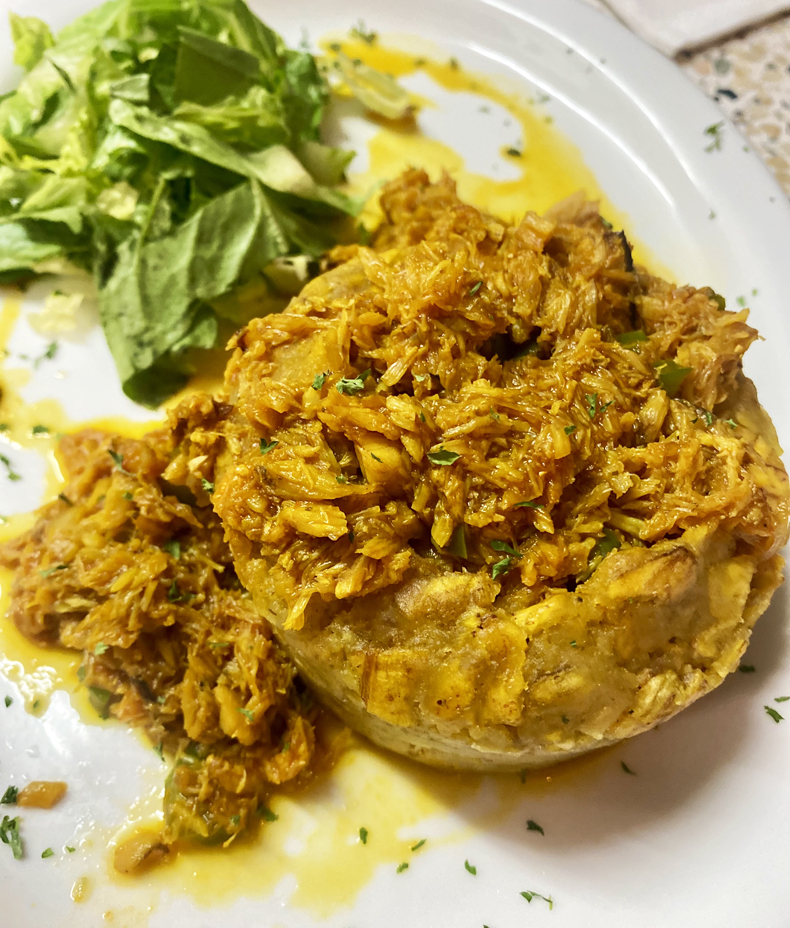
Mofongo with jueyes
In Fajardo, we loved the mofongo with shredded jueyes, local land crabs, at casual waterfront restaurant Costa Mía (PR 987, Las Croabas, map)—and please pair it with some of the restaurant’s super simple yet deeply flavored fish broth; we wound up ordering three cups of that! In Old San Juan, we’ve heard good things about the mofongo at Café Manolín (251 Calle de San Justo, map), an old-school lunch counter kind of place.
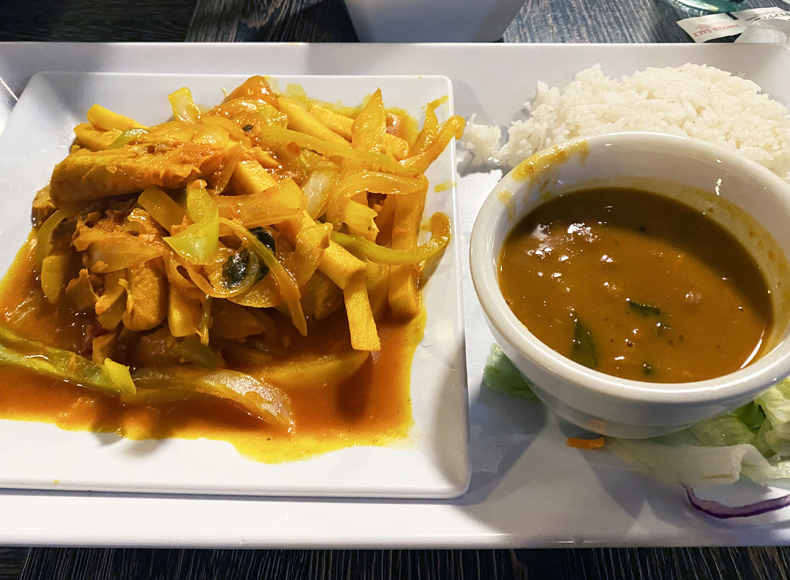
Bacalao guisado
This tomato-based salt cod fish stew is a staple home-cooked dish in Puerto Rico, particularly during Lent, and it’s a terrific dish to look for at less-casual seafood restaurants. It’s reminiscent of Spanish and Portuguese cuisine, thanks to the cod itself, but there’s an unmistakable Puerto Rican flavor as well, due to the sofrito and sazón (seasoning) used. Onions, peppers, and garlic also typically play a role, as well as potatoes. Paired with some white rice, salad, and avocado, it’s a fantastic lunch or dinner.
Where: We were fortunate to find a good version of this in a rather touristy place, at Julius Restaurant in Condado (1128 Ashford Ave., map). I loved the French fry cuts of boiled potato in this, and that we could pair it with rice and habichuelas, soupy beans (see below). We also really enjoyed the comforting asopao de pollo, a chicken and rice stew, and the arroz con calamares here. It was all just as tasty the next morning, when we polished off our leftovers!

Queso frito con guayaba
Perfectly fried cubes of cheese are paired with a guava dipping sauce for this popular Puerto Rican appetizer. The cheese is likely queso blanco or queso fresco, something mild, unaged, and semi-soft. It’s impossible not to enjoy this classic savory-sweet pairing.
Where: We ate this multiple times on the island—it is especially kid-friendly, as you can imagine—but we particularly loved the smaller cut and crispy fry on the queso at La Taberna Lúpulo (151 Calle de San Sebastián, map), a beloved beer bar in Old San Juan. (Also, we can attest that fried cheese goes quite well with local beer flights!)
Queso frito con guayaba made a good appetizer at Café Playero (Carretera PR 987 Sector Las Croabas Final KM 6.8, map), conveniently located very near to where the bioluminescent bay tours leave in Fajardo, as well.

Quesito
Quesitos are the type of pastries that visiting or returning Puerto Ricans will go straight to a bakery to stock up on for that immediate taste of home. Ideally paired with a morning coffee, they’re decadent fingers of pastry filled with sweet cream cheese, baked, and brushed with honey once out of the oven, imparting a sweet, sticky gloss.
Where: We scored some sticky-delicious quesitos from Kasalta (1966 McLeary Ave., map), a popular bakery (that’s also a restaurant and bar) in Ocean Park where former President Obama famously once stopped for a medianoche. No matter your politics, it’s hard not to like this place and its diverse menu of house-baked items. Tip: Find the pastries (including quesito), desserts, and cakes behind the glass in the middle of the counter. If it’s a sandwich you want, head all the way to the far end to order (we loved the pernil and cantimpalo sandwiches for a takeout beach lunch; see below).
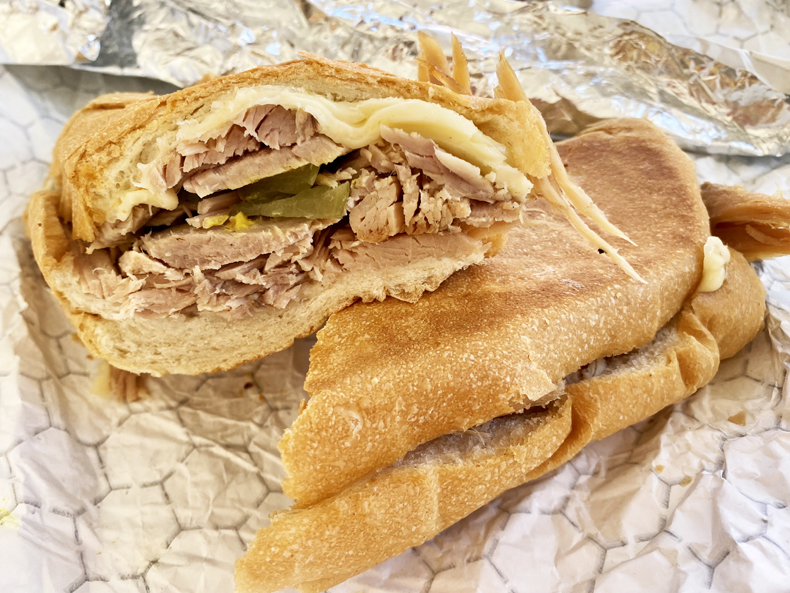
Pernil
Puerto Rico’s beloved roast pork, pernil, is an easy one to love: tender, garlicky pork shoulder seasoned with adobo, hopefully served with some crispy pork skin. You’ll often see it paired with rice and arroz con gandules (rice and pigeon peas) or tostones, as a main course, but we enjoyed ours on this trip in sandwich form.
Where: The pernil sandwich from Kasalta (1966 McLeary Ave., map), a popular bakery/restaurant/bar in Ocean Park, came on fresh house-made bread with some Swiss cheese, mustard, and pickle. It was a super satisfying lunch we brought to the beach one day, along with an excellent cantimpalo sandwich, which pairs sliced chorizo with ham and cheese. To order the sandwiches, find the counter at the far end of this bakery

Arroz y Habichuelas
Puerto Rican rice and beans are a dream, so simple and homey and satisfying. Fluffy white rice, usually medium- or long-grain, is served alongside soupy pink or red beans, often kidney or pinto beans. (Sometimes the rice is con gandules, or pigeon peas.) The beans are deeply flavored with your typical sofrito—made, essentially, with culantro, a citrusy, peppery herb; and sazón—and often come studded with hunks of potato or squash (calabaza). It’s the ultimate Puerto Rican comfort food.
Where: You certainly don’t need to go anywhere special to find good arroz y habichuelas. We loved these habichuelas at Molini’s Cafe (1857 Calle Loíza, map) in chill Ocean Park, which happened to be an all-around excellent restaurant. But we also enjoyed the rice and beans sold from the food counter inside the pharmacy around the corner from the house we rented in the same neighborhood: Farmacia Americana, 1854 Calle Loíza, map). Every morning it posted a short menu of local dishes, while selling fresh bread, pastries, and coffee too.
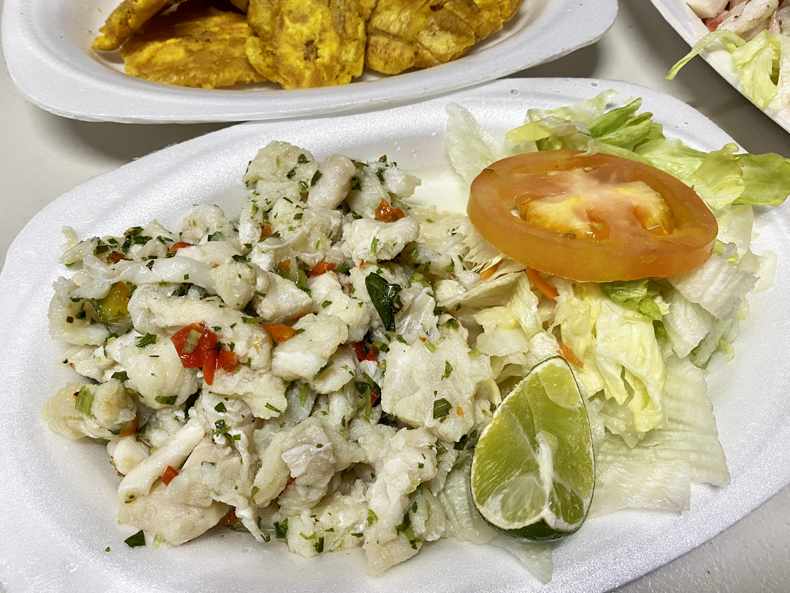
Ceviche
Fresh raw fish or shrimp marinated in lime juice, chilies, salt, and cilantro is a very common snack along Puerto Rico’s coast, and it’s an absolute delight to eat. Typically paired with tostones, fried plantain chips, and prepared with a fish like mero (grouper), ceviche is a wonderfully bright and refreshing appetizer or light main meal, perfect for sharing. We certainly ate our share of it in the San Juan and Fajardo areas.
Where: We loved the open-air Kiosko Freddy, El Rey del Mofongo (corner of calles Degetau & Corona; 939-260-2233, map) in Ocean Park. It’s a very casual streetside spot with delicious mofongo and fish ceviche, the latter refreshingly citrusy, well-portioned (for $14.99), and served with a pile of hot tostones. What could be better?

Filet de mero empanado
Fish, such as grouper or red snapper, that’s been breaded (empanado) and fried turns up on a lot of coastal menus, and it is delicious. Puerto Ricans know how to fry, whether it’s a hefty plantain-taro fritter (see below) or a delicate filet of fish. It’s an unmissable lunch or dinner near the coast.
Where: We discovered how much we love this dish at the excellent Molini’s Cafe (1857 Calle Loíza, map), a neighborhood restaurant near our house rental in Ocean Park. The fish, perfectly fried, was red snapper here, and it came smothered in sautéed peppers and onions and served alongside rice and tostones. What a beautiful meal! It was a favorite on this trip.
FRITANGA
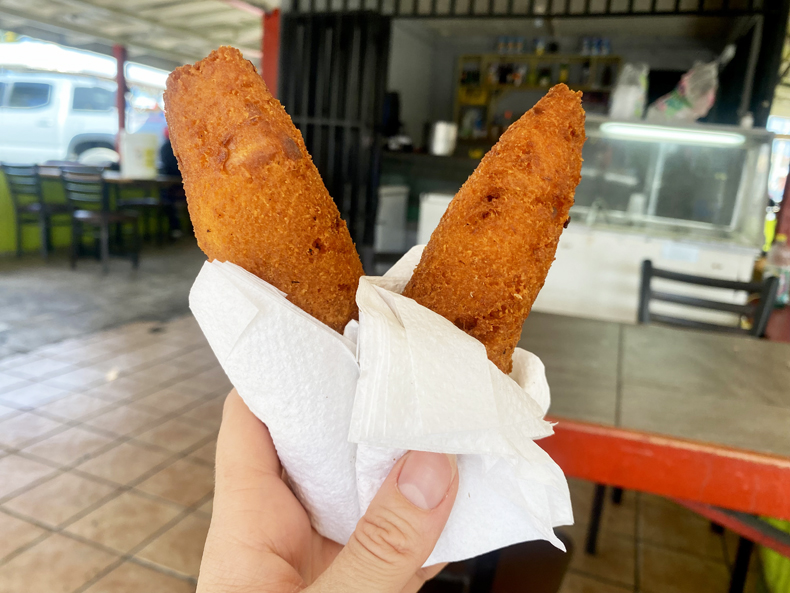
Alcapurria
In a land famed for its fritanga (fried foods), alcapurrias are among the most beloved, and lucky for any visitor to the north coast, this area is the best for them. Alcapurrias are elongated, burnt-orange fritters made with green banana and taro root, flavored with sofrito, and filled with ground meat (carne), crab (jueyes), and more. They are said to be best in the Piñones area, in Loíza, where the wooden, open-air kioskos selling these and other fried items line the roadside near the coast. Crispy on the outside, soft and savory in the middle, they make delicious beach (or road trip) snacks. We couldn’t get enough of them.
Where: It’s hard to pick just one kiosk while cruising along the waterfront drag in Piñones, but we went with “the house of alcapurrias,” aka Sabor a Piñones (La casa de las alcapurrias), map, where we got a couple with jueyes. It did not disappoint. (We also tried the bacalaítos here, and pastelillo with pulpo, or octopus; see below—all delicious.) The kioskos de Luquillo (map) are another great bet for these.
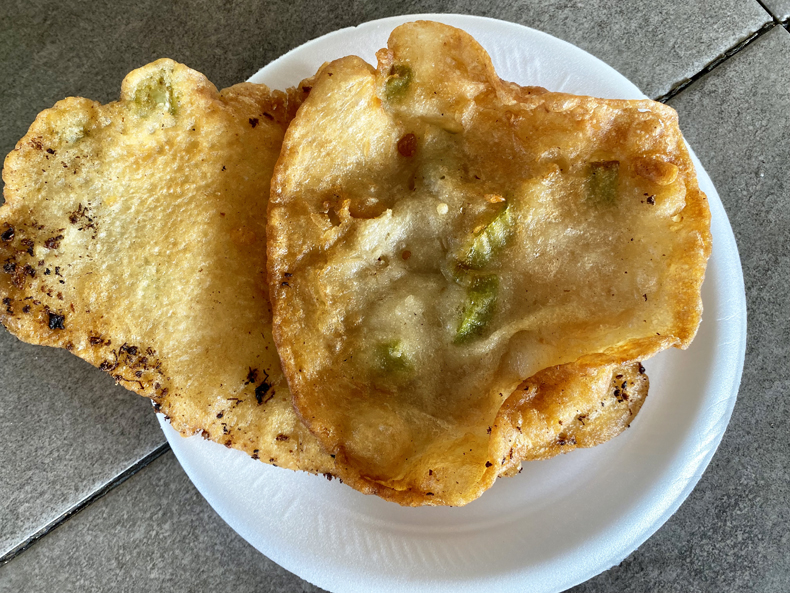
Bacalaítos
Bacalaítos are very popular salted codfish fritters the size of an outstretched hand, deep-fried till crisp along the edges while remaining soft in the center. Recipes vary, but they’re generally simply made with flour, salted cod, garlic, cilantro, and sometimes green pepper, and exceedingly fun to eat. Again, a savory fried beach or road snack? Sign us up.
Where: At Sabor a Piñones (La casa de las alcapurrias), a roadside kiosk in Pinones, bacalaítos were fried to order in front of us and cost $2 each. Unbeatable!

Pastelillo
In other parts of Puerto Rico, they might call this an empanadilla, and those of us from outside the culture might unknowingly call it an empanada. But in the north of the island, these deep-fried wheat-based pastries with savory fillings are called pastelillos, and they’re delicious local snacks that can be filled with all manner of seafood and meat: beef, chicken, pork, lobster, crab, fish, conch, shrimp. You name it.
Where: Pastelillos are standard fare among the north coast’s casual seafood eateries and kiosks, which specialize in tasty fried things. We kicked off a lunch feast at Carlos Seafood (9977+H86, Carr. Cabezas de San Juan, map) in Fajardo with a pastelillo filled with lobster, and ate a delicious octopus-stuffed specimen at the Sabor a Piñones (La casa de las alcapurrias) kiosk in Piñones. Also look for these at the Luquillo kiosks (map).
DRINKS
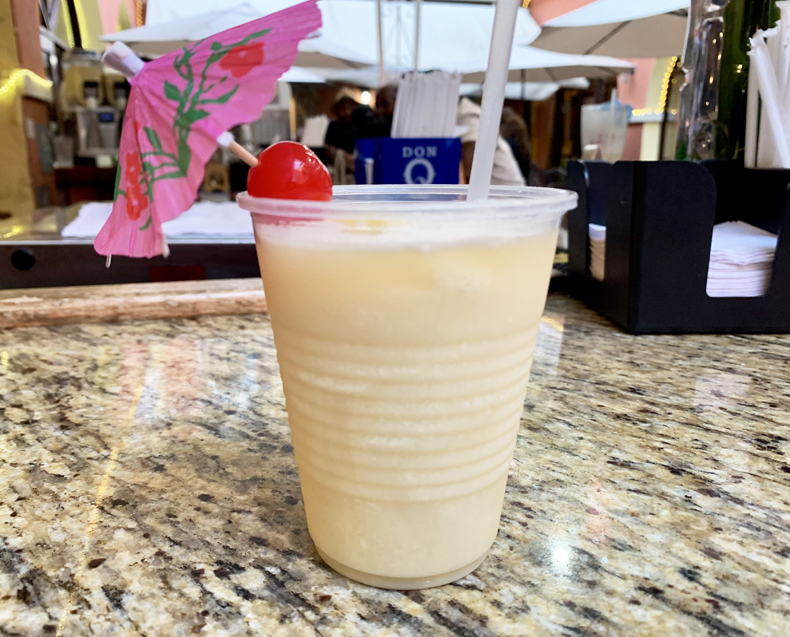
Piña colada
The ultimate tropical vacation cocktail has supposed roots in Old San Juan: At Barrachina in 1963, a bartender named Don Ramon Portas Mingot concocted the famous drink. (A plaque outside Barrachina commemorates this.) Nowadays the drink is everywhere, and just as popular as a bedecked nonalcoholic drink served in a carved-out pineapple to lucky kids on beaches as it is poured into a cup for happy hour. Sweet and refreshing and immediately summoning the tropics, it is popular for good reason.

A nonalcoholic piña colada from a beach vendor
Where: Barrachina (104 Calle de la Fortaleza, San Juan, map) does serve a particularly delicious piña colada, appropriately bedecked with an umbrella and a cherry, for about $7, and you can take it to go while you continue exploring the charming streets of Old San Juan. From a beach vendor at the cute, family-friendly Playita del Condado (map), we tried the nonalcoholic version (served in the pineapple for $12.99, alongside pineapple slices) and can confirm it’s likewise excellent. (We also saw a number of adults adding their own rum to it, so come prepared if that’s your plan!)

Batido
Batidos are smoothies, typically made with fruit, milk, and ice—a tasty treat to cool off with on a hot day. But there are a few caveats. They can sometimes be quite the commitment here, and practically a meal. You may think you’re getting a health-conscious smoothie, but unless otherwise specified, batidos are generally quite sweet, served with whipped cream, a cherry or two, and possibly even a couple of cookies. One we tried came topped with gummy candy! It’s an art form, and absolutely delicious.
Where: Our amazing (dessert!) batido is from the Fruitty World truck that parked next to the Luquillo kiosks (map), but look for these along roadsides and from small eateries everywhere.

Local Puerto Rican beer
If you are a beer drinker, you’ll surely be reaching for lots of Medalla Light while in Puerto Rico. It’s cheap and light indeed, a great session beer that won’t dehydrate you terribly. But you’ll also want to check out the growing microbrewery scene on the island. In the San Juan area, there’s Ocean Lab Brewing and Old Harbor Brewing, both in Carolina, and brewpubs like Cervecería del Callejón, in Old San Juan. The easiest way to taste some locally brewed beers? Visit a craft beer bar that offers tastings.
Where: If you can score a window-facing table at La Taberna Lúpulo (151 Calle de San Sebastián, map), you’ll be in prime position to catch the outdoor breeze while sipping on local beers (and snacking, if you wish—we loved the aforementioned queso frito con guayaba here). This bar has one of the most diverse beer catalogs on Puerto Rico, spanning brews made both locally and globally. We asked for samplers of all the PR beers and received tasty mini pours that included Boxlab’s delicious fruited sour and Ocean Lab’s amber lager.
There has never been a better time to plan your next trip and make your Dream vacation a reality . Whether you've been dreaming of relaxing on a sun-kissed beach, exploring ancient cities, or embarking on an epic adventure, now is the perfect moment to make it happen.


